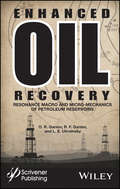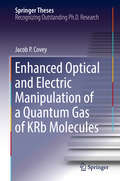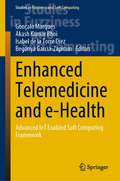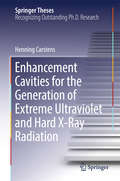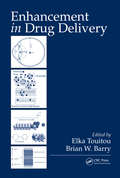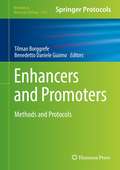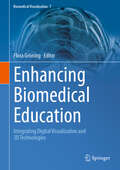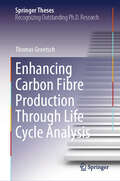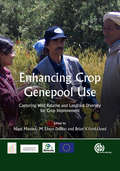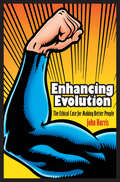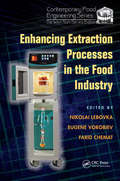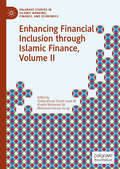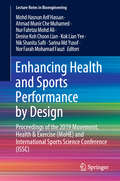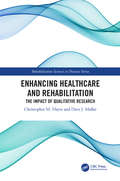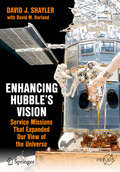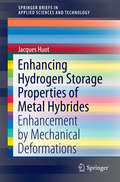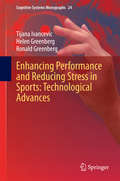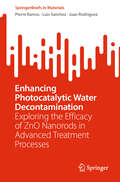- Table View
- List View
Enhanced Oil Recovery: Resonance Macro- and Micro-Mechanics of Petroleum Reservoirs
by R. F. Ganiev L. E. Ukrainsky O. R. GanievFossil fuels, especially petroleum, are still the primary energy source all over the world. With the advent of hydraulic fracturing (i.e. “fracking”), directional drilling, and other technological advances, petroleum and reservoir engineers all over the world have been able to produce much greater results, in much more difficult areas, than ever before, to meet higher global demand. “Enhanced oil recovery (EOR)” is one of the hottest and most important topics in this industry. New technologies and processes must be continually discovered and developed, even as renewable energy begins to grow and become more fruitful, as the demand for more and more energy continues to grow worldwide. This groundbreaking and highly anticipated study discusses the scientific fundamentals of resonance macro- and micro-mechanics of petroleum reservoirs and its petroleum industry applications. It contains an overview of the research and engineering results of resonance macro- and micro-mechanics of petroleum reservoirs, which provide the scientific and applied foundations for the creation of groundbreaking wave technologies for production stimulation and enhanced oil recovery. A valuable tool for the petroleum or reservoir engineer in the field, this volume is also intended for students, teachers, scientists and practitioners who are interested in the fundamentals, development, and application of leading-edge technologies in the petroleum industry and other industrial sectors.
Enhanced Optical and Electric Manipulation of a Quantum Gas of KRb Molecules (Springer Theses)
by Jacob P. CoveyThis thesis describes significant advances in experimental capabilities using ultracold polar molecules. While ultracold polar molecules are an idyllic platform for quantum chemistry and quantum many-body physics, molecular samples prior to this work failed to be quantum degenerate, were plagued by chemical reactions, and lacked any evidence of many-body physics. These limitations were overcome by loading molecules into an optical lattice to control and eliminate collisions and hence chemical reactions. This led to observations of many-body spin dynamics using rotational states as a pseudo-spin, and the realization of quantum magnetism with long-range interactions and strong many-body correlations.Further, a 'quantum synthesis' technique based on atomic insulators allowed the author to increase the filling fraction of the molecules in the lattice to 30%, a substantial advance which corresponds to an entropy-per-molecule entering the quantum degenerate regime and surpasses the so-called percolations threshold where long-range spin propagation is expected.Lastly, this work describes the design, construction, testing, and implementation of a novel apparatus for controlling polar molecules. It provides access to: high-resolution molecular detection and addressing; large, versatile static electric fields; and microwave-frequency electric fields for driving rotational transitions with arbitrary polarization. Further, the yield of molecules in this apparatus has been demonstrated to exceed 10^5, which is a substantial improvement beyond the prior apparatus, and an excellent starting condition for direct evaporative cooling to quantum degeneracy.
Enhanced Polarisation Control and Extreme Electric Fields: Advances in Terahertz Spectroscopy Applied to Anisotropic Materials and Magnetic Phase Transitions (Springer Theses)
by Connor Devyn MosleyThis thesis reports advances in terahertz time-domain spectroscopy, relating to the development of new techniques and components that enhance the experimentalist’s control over the terahertz polarisation state produced by photoconductive emitters. It describes how utilising the dynamic magnetoelectric response at THz frequencies, in the form of electromagnons, can probe material properties at a transition between two magnetically ordered phases. Additionally, preliminary investigations into the properties of materials exposed to extreme terahertz optical electric fields are reported.The work presented in this thesis may have immediate impacts on the study of anisotropic media at THz frequencies, with photoconductive emitters and detectors being the most commonly used components for commercially available terahertz spectroscopy and imaging systems, and by providing a new way to study the nature of magnetic phase transitions in multiferroics. In the longer term the increased understanding of multiferroics yielded by ultrafast spectroscopic methods, including terahertz time-domain spectroscopy, may help develop new magnetoelectric and multiferroic materials for applications such as spintronics.
Enhanced Telemedicine and e-Health: Advanced IoT Enabled Soft Computing Framework (Studies in Fuzziness and Soft Computing #410)
by Akash Kumar Bhoi Gonçalo Marques Isabel de la Torre Díez Begonya Garcia-ZapirainIn recent years, new applications on computer-aided technologies for telemedicine have emerged. Therefore, it is essential to capture this growing research area concerning the requirements of telemedicine. This book presents the latest findings on soft computing, artificial intelligence, Internet of Things and related computer-aided technologies for enhanced telemedicine and e-health. Furthermore, this volume includes comprehensive reviews describing procedures and techniques, which are crucial to support researchers in the field who want to replicate these methodologies in solving their related research problems. On the other hand, the included case studies present novel approaches using computer-aided methods for enhanced telemedicine and e-health. This volume aims to support future research activities in this domain. Consequently, the content has been selected to support not only academics or engineers but also to be used by healthcare professionals.
Enhancement Cavities for the Generation of Extreme Ultraviolet and Hard X-Ray Radiation (Springer Theses)
by Henning CarstensThis thesis discusses the power scaling of ultrashort pulses in enhancement cavities, utilized in particular for frequency conversion processes, such as Thomson scattering and high-harmonic generation. Using custom optics for ultrashort-pulse enhancement cavities, it demonstrates for the first time that at the envisaged power levels, the mitigation of thermal effects becomes indispensable even in cavities comprising solely reflective optics. It also studies cavities with large beams, albeit with low misalignment sensitivity, as a way to circumvent intensity-induced mirror damage. Average powers of several hundred kilowatts are demonstrated, which benefit hard x-ray sources based on Thomson scattering. Furthermore, pulses as short as 30 fs were obtained at more than 10 kW of average power and employed for high-harmonic generation with photon energies exceeding 100 eV at 250 MHz repetition rate, paving the way for frequency comb spectroscopy in this spectral region.
Enhancement in Drug Delivery
by Elka Touitou Brian W. BarryProviding a significant cross-fertilization of ideas across several disciplines, Enhancement in Drug Delivery offers a unique comprehensive review of both theoretical and practical aspects of enhancement agents and techniques used for problematic administration routes. It presents an integrated evaluation of absorption enhancers and modes fo
Enhancers and Promoters: Methods and Protocols (Methods in Molecular Biology #2351)
by Tilman Borggrefe Benedetto Daniele GiaimoThis volume contains cutting-edge techniques to study the function of enhancers and promoters in depth. Chapters are divided into six sections and describe enhancer-promoter transcripts, nucleosome occupancy, DNA accessibility, chromatin interactions, protein-DNA interactions, functional analyses, and DNA methylation assays. Written in the Methods in Molecular Biology series format, chapters include comprehensive introductions, lists of the necessary materials and reagents, step-by-step laboratory protocols, and useful suggestions for troubleshooting.Authoritative and cutting-edge, Enhancers and Promoters: Methods and Protocols is a useful guide for future experiments.
Enhancing Adolescents' Motivation for Science: Research-Based Strategies for Teaching Male and Female Students
by Lee B. Shumow Jennifer A. SchmidtBecause motivation is the key to scientific literacy Within every science classroom there are students waiting to be inspired. All these students need is the right motivation. That’s exactly what this one-of-a kind guide will help you provide. And along the way, you’ll quickly learn that the motivational tools that are most effective with adolescent boys don’t always work with adolescent girls—and vice versa. Part book, part website, this resource • Details research-proven motivational constructs specific to science • Addresses gender differences that influence motivation • Describes how to make science learning relevant and enjoyable • Builds confidence, especially among girls • Offers motivational strategies that are consistent with the NGSS
Enhancing Biomedical Education: Integrating Digital Visualization and 3D Technologies (Biomedical Visualization #7)
by Flora GröningThis edited book explores digital visualization as a tool to communicate complex and often challenging biomedical content in an accessible and engaging way. The reader will learn how current visualization technology can be applied to a wide range of biomedical fields to benefit the learning of students and enhance the public understanding of science. The focus of this volume will be on the innovative use of digital visualization (2D or 3D) in biomedical education and public engagement. This includes medical imaging (i.e., magnetic resonance imaging and computed tomography) as well as other digital imaging techniques such as laser scanning. It also covers the use of state-of-the-art visualization tools (i.e., augmented and virtual reality, animations and 3D printing) and the integration of 3D models of anatomical structures into serious computer games. This book will appeal to educators, researchers and students in life science subjects as well as to healthcare professionals and designers of digital learning resources. The book will be a source of inspiration for any reader who is interested in using digital visualization as a meaningful and engaging communication tool for biomedical content, ranging from the anatomy and function of organs to the mechanisms of diseases and their prevention.
Enhancing Carbon Fibre Production Through Life Cycle Analysis (Springer Theses)
by Thomas GroetschThis book describes the application of life cycle assessment (LCA) methodology to streamline analysis of process and material variations in carbon fibre manufacturing, focusing on large-scale continuous production. It reports on a modular LCA concept based on accepted international standards and an in-depth analysis of carbon fibre manufacture. This streamlined assessment approach considers material flows and properties, and generated emissions, throughout the manufacturing process. Further, four manufacturing scenarios for optimizing material throughput are discussed, highlighting trade-offs between production rate, material properties, environmental impact, and cost. In turn (“Subsequently” or a synonym may be more suitable here as this part is not directly linked to what is described in the previous sentence), the evaluation of three precursor materials,traditional PAN, textile-grade PAN, and an experimental bio-based lignin-cellulose blend is described. The strengths and weaknesses, like processability and cost efficiency, of each material are outlined in detail. Overall, this book offers a comprehensive analysis of the effect process and material variations have on carbon fiber manufacture. It also showcases methodologies to optimize these industrial processes for a sustainable production on a large scale.
Enhancing Christian Life: How Extended Cognition Augments Religious Community
by Brad D. Strawn Warren S. BrownNo one is really Christian on their own. But often the religious life is seen as individual, private, and internal—resulting in a truncated, consumeristic faith. And what if that kind of individualistic Christianity is built on a fundamental misunderstanding of human nature? According to psychologists Brad Strawn and Warren Brown, it's time to rethink the Christian life in light of current research on the human mind, particularly with a deeper understanding of the process called "extended cognition." Using insights from neuroscience, psychology, and philosophy, they argue in Enhancing Christian Life that persons must be understood as not only embodied and embedded within particular contexts, but also extended beyond the body to encompass aspects of the physical and social world. Embracing a vision of the Christian life as extended into interactions with a local network of believers, they help us discover a fuller, more effective way to be Christian. After exploring the psychological dynamics of extended cognition, including how the mind is "supersized" by the incorporation of physical tools and social networks, Strawn and Brown consider implications for spiritual practices, congregational life, and religious language and traditions, which they describe as mental "wikis." The formation of robust Christian life, they show, is a process that takes place within a larger mesh of embodiment and mind—broader, deeper, and richer than we could ever be on our own.
Enhancing Citizens’ Role in Public Safety: Interaction, Perception and Design of Mobile Warning Apps (Technology, Peace and Security I Technologie, Frieden und Sicherheit)
by Jasmin HaunschildThe COVID-19 pandemic and the war in Ukraine emphasize the need for greater disaster resilience and preparedness. This book investigates how these apps can enhance crisis awareness and citizen involvement in disaster prevention and response. By examining user perspectives and the impact of crisis experiences, the book explores how to increase the adoption and effectiveness of warning apps. The research uses qualitative and quantitative methods, including surveys and design interventions, to reveal current usage, changes over time and desired features. It shows that while citizens find warning apps helpful, more safety-related features and two-way communication could increase their appeal. Additionally, the integration of preparedness features into these apps can increase their perceived usefulness, though challenges remain in addressing user expectations and design preferences across different crises and cultural contexts.
Enhancing Crop Genepool Use: Capturing Wild Relative and Landrace Diversity for Crop Improvement
by Nigel Maxted Ben Vosman Brian Ford-Lloyd Jeremy Pritchard Colette Broekgaarden M Ehsan DullooMaintaining food security in the face of human population increase and climate change is one of the critical challenges facing us in the 21st Century. Utilisation of the full range of agrobiodiversity will be a necessary tool in addressing this challenge. In this book a team of international contributors review all aspects of utilization and conservation of crop wild relative (CWR) and landrace (LR) diversity as a basis for crop improvement and future food security. Enhancing Crop Genepool Use covers four key areas: · Characterization techniques - novel 'omics' techniques and predictive tools that can be used to identify adaptive traits and expedite plant breeding. · Conservation strategies - how to develop national, regional and global CWR and LR conservation strategies, how better to target conservation to meet the needs of the plant breeding community, and how to integrate CWR and LR diversity into existing biodiversity conservation programmes. · Facilitating CWR and LR use - pre-breeding using 'exotic' germplasm, meeting breeders' needs, integrating the conservation and user communities, and policy enhancement. · Informatics development - improving characterization, trait and conservation data management and accessibility, and inter-information system operability. This book will appeal to a wide array of specialists and postgraduate students, such as those working in the fields of agrobiodiversity conservation and use, conservation, ecology, botany, genetics, plant breeding and agriculture.
Enhancing Crop Genepool Use: Capturing Wild Relative and Landrace Diversity for Crop Improvement
by Ben Vosman Brian Ford-Lloyd Jeremy Pritchard Colette BroekgaardenBased on the 2014 'Enhanced Genepool Utilization ? Capturing wild relative and landrace diversity for crop improvement' conference , in this book a team of international contributors address all aspects of utilization and conservation of crop wild relative (CWR) and landrace (LR) diversity for crop improvement. Focussing on characterisation techniques, conservation strategies, facilitating CWR and LR use and informatics development, this book highlights exotic plant germplasm as a potentially critical but neglected resource for crop improvement.
Enhancing Environmental Education Through Nature-Based Solutions (Integrated Science #4)
by Clara Vasconcelos Cristina S. C. CalheirosThis Book presents innovative and state of the art studies developed in Environmental Education in different countries to highlight this theme and promote its implementation all over the world. It will give a scientific perspective of Nature-based solutions to promote environmental education in all citizens and a more educational perspective as to how this approach can be implemented at schools and universities. Not less important is that includes science communication as a key factor for training and disseminating about the environment. The invited authors are recognized experts with excellent work developed in Environmental Education.This contributed volume presents innovative and creative work in the area giving a step forward in the implementation of Environmental Education, namely as a target of 2020 United Nations Agenda for Sustainable Development. The invitation of authors from many different countries allows the creation of a network and subsequently the book will bring concrete ideas as to how to develop operational capacities to bring added values to Environmental Education at an international level.
Enhancing Evolution: The Ethical Case for Making Better People (Science Essentials Ser.)
by John HarrisIn Enhancing Evolution, leading bioethicist John Harris dismantles objections to genetic engineering, stem-cell research, designer babies, and cloning and makes an ethical case for biotechnology that is both forthright and rigorous. Human enhancement, Harris argues, is a good thing--good morally, good for individuals, good as social policy, and good for a genetic heritage that needs serious improvement. Enhancing Evolution defends biotechnological interventions that could allow us to live longer, healthier, and even happier lives by, for example, providing us with immunity from cancer and HIV/AIDS. Further, Harris champions the possibility of influencing the very course of evolution to give us increased mental and physical powers--from reasoning, concentration, and memory to strength, stamina, and reaction speed. Indeed, he says, it's not only morally defensible to enhance ourselves; in some cases, it's morally obligatory. In a new preface, Harris offers a glimpse at the new science and technology to come, equipping readers with the knowledge to assess the ethics and policy dimensions of future forms of human enhancement.
Enhancing Extraction Processes in the Food Industry (Contemporary Food Engineering)
by Eugene Vorobiev Nikolai Lebovka Farid ChematExtraction is an important operation in food engineering, enabling the recovery of valuable soluble components from raw materials. With increasing energy costs and environmental concerns, industry specialists are looking for improved techniques requiring less solvents and energy consumption. Enhancing Extraction Processes in the Food Industry is a
Enhancing Financial Inclusion through Islamic Finance, Volume II (Palgrave Studies in Islamic Banking, Finance, and Economics)
by Khalifa Mohamed Ali Abdelrahman Elzahi Saaid Ali Mohamed Hassan AzragThis book is the second of two volumes which highlight the concept of financial inclusion from the Islamic perspective. An important element of the Sustainable Development Goals (SDGs), financial inclusion has been given significant prominence in reform and development agendas proposed by the United Nations and G-20. The significance of Islamic financial inclusion goes beyond improved access to finance to encompass enhanced access to savings and risk mitigation products, as well as social inclusion that allows individuals and companies to engage more actively in the real economy. It represents one of the important drivers of economic growth. This volume explores the financial risks associated with lending to low-income groups due to high poverty levels and the lack of collateralization mechanisms. The first book on the market to provide empirical evidence of Islamic microfinance, deposit insurance and micro-entrepreneurship through the analysis of models and country case studies, this edited collection will be of value to those researching development finance, financial inclusion and Islamic finance.
Enhancing Forest Resilience through Plant Functional Traits: A Practical Approach
by Amit Kumar Narendra Kumar Pramod Kumar PandeyThis book explores the relationship between plant functional traits and the resilience of forest ecosystems. Understanding how these traits influence forest ecosystems has significant implications for conservation, forestry, and ecosystem management. This book explores the intersection of ecology, botany, and forestry, providing a comprehensive guide to using plant functional traits as a tool to advance sustainable forest development as sustainable forest management becomes increasingly important in the face of global environmental challenges.This book also discusses the role that plant functional traits play in ecosystem dynamics and how they support forest resilience. It emphasizes how crucial these characteristics are for dealing with environmental stresses like drought and climate change, as well as how they affect soil interactions, carbon sequestration, and nutrient cycling. By integrating contemporary developments in trait-based research and analytical instruments, this book provides useful tactics for improving forest resilience via sustainable management techniques.Key Features:· A comprehensive overview of the latest advancements in plant functional traits and their role in forest resilience.· Detailed explanations of the anatomical, physiological, and genetic aspects of plant functional traits, emphasizing their importance in tree growth and adaptation.· Insights into how functional traits influence nutrient cycling, carbon sequestration, soil interactions, and responses to environmental stressors like drought and climate change.· Discussion of modern tools and methodologies in trait-based research, along with future directions for integrating functional traits into forest management strategies.· Practical applications of functional traits in conservation, biodiversity management, and sustainable forest management to enhance ecosystem resilience.This book serves as a valuable reference for researchers and academicians studying species composition within forest ecosystems and exploring ways to enhance forest resilience in the context of climate change. It is also suitable as a textbook for graduate, postgraduate, and Ph.D. students in fields such as agriculture, botany, plant physiology, forestry, biotechnology, environmental science, and agroforestry.
Enhancing Health and Sports Performance by Design: Proceedings of the 2019 Movement, Health & Exercise (MoHE) and International Sports Science Conference (ISSC) (Lecture Notes in Bioengineering)
by Mohd Hasnun Arif Hassan Ahmad Munir Che Muhamed Nur Fahriza Mohd Ali Denise Koh Choon Lian Kok Lian Yee Nik Shanita Safii Sarina Md Yusof Nor Farah Mohamad FauziThis book gathers papers presented at the 2019 Movement, Health & Exercise (MoHE) Conference and International Sports Science Conference (ISSC). The theme of this year’s conference was "Enhancing Health and Sports Performance by Design". The content covers (but is not limited to) the following topics: exercise science; human performance; physical activity & health; sports medicine; sports nutrition; management & sports studies; and sports engineering & technology.
Enhancing Healthcare and Rehabilitation: The Impact of Qualitative Research (Rehabilitation Science in Practice Series)
by Christopher M. Hayre Dave J. MullerSummary Description This book is primarily a celebration of the qualitative work undertaken internationally by a number of experienced researchers. It also focuses on developing the use of qualitative research for health and rehabilitative practitioners by recognizing its value methodologically and empirically. We find that the very nature of qualitative research offers an array of opportunities for researchers in being able to understand the social world around us. Further, through experience and discussion, this book identifies the multifaceted use of qualitative methods in the healthcare and rehabilitative setting. This book touches on the role of the researcher, the participants involved, and the research environment. In short, we see how these three central elements can affect the nature of qualitative work in attempts to offer originality. This text speaks to a number of audiences. Students who are writing undergraduate dissertations and research proposals, they may find the myriad of examples stimulating and may support the rationale for methodological decisions in their own work. For academics, practitioners, and prospective qualitative researchers this book also aims to demonstrate an array of opportunism in the field of qualitative research and how they may resonate with arguments proffered. It is anticipated that readers will find this collection of qualitative examples not only useful for informing their own research, but we also hope to enlighten new discussions and arguments regarding both methodological and empirical use of qualitative work internationally. Features Encompasses the importance of qualitative research and how it can be used to facilitate healthcare and rehabilitation across a wide range of health conditions. Evaluates empirical data whilst critically applying it to contemporary practices. Provides readers with an overview with future directions and influence policy makers in order to develop practice. Focuses on an array of health conditions that can affect groups of the population, coincided with life issues and the care and family support received. Offers innovative methodological insights for prospective researchers in order to add to the existing evidence base.
Enhancing Hubble's Vision
by David J. Shayler David M. HarlandThis book tells the story of the four missions to maintain Hubble's successful operation. Between 1997 and 2009 these repaired, serviced and upgraded the instruments on the telescope to maintain its state-of-the-art capabilities. It draws on first hand interviews with those closely involved in the project. The spacewalking skills and experiences gained from maintaining and upgrading Hubble had direct application to the construction of the International Space Station and help with its maintenance. These skills can be applied to future human and robotic satellite servicing and maintenance activities as well, not only in Earth orbit but at locations deeper in space. A companion to this book, The Hubble Space Telescope: From Concept to Success, relates the events of the Telescope's launch in 1990 and its rough start, after a 20-year struggle to place a large optical telescope in orbit. Originally intended to operate for fifteen years, Hubble has just passed its 25th anniversary, and there is every expectation that it will survive for thirty years. Despite its early problems, the Hubble Space Telescope has become a lasting legacy of the Space Shuttle program, and indeed is a national treasure.
Enhancing Hydrogen Storage Properties of Metal Hybrides
by Jacques HuotThis book shows how severe plastic deformation techniques could be used to enhance the hydrogen storage properties of metal hybrides. The mechanochemical techniques of ball-milling (BM), Cold Rolling (CR), Equal Chanel Angular Pressing (ECAP) and High Pressure Torsion (HPT) are covered. Each technique is described and critically assessed with respect to its usefulness to process metal hybrides at an industrial scale.
Enhancing Performance and Reducing Stress in Sports: Technological Advances
by Tijana Ivancevic Helen Greenberg Ronald GreenbergThis book is designed to help athletes and individuals interested in high sports performance in their journey towards the perfection of human sports abilities and achievements. It has two main goals: accelerating the acquisition of motor skills and preparing and vigilantly reducing the recovery time after training and competition. The Diamond Sports Protocol (DSP) presents state-of-the-art techniques for current sport and health technologies, particularly neuromuscular electrical stimulation (Sports Wave), oxygen infusion (Oxy Sports), infrared (Sports Infrared Dome) and lactic acid cleaning (Turbo Sports). The book suggest DSP as an essential part of every future athlete's training, competition and health maintenance. The book is for everyone interested in superior sports performance, fast and effective rehabilitation from training and competition and sports injury prevention.
Enhancing Photocatalytic Water Decontamination: Exploring the Efficacy of ZnO Nanorods in Advanced Treatment Processes (SpringerBriefs in Materials)
by Pierre Ramos Luis Sánchez Juan RodríguezThe book reviews the fundamentals of advanced oxidation processes (AOPs) technologies to degrade hazardous organics via photocatalysis of 1-dimensional zinc-oxide (ZnO). One-dimensional ZnO nanorods (ZnO-NRs) have been of utmost interest due to their high surface area, efficient charge transport, and superior photosensitivity. These features make ZnO-based nanorods exciting candidates for applications in photocatalysis. Even though photocatalysis using bare ZnO nanorods is useful in pollutant remediation, several drawbacks such as high recombination of photo−excited charge carriers and ineffective operation of sunlight make it less effective. This book thus presents a review of the current modification strategies carried out to increase the ZnO nanorods photoactivity, such as enhancing the photocatalytic activity of ZnO through modification of its electronic and optical properties, doping metal/nonmetal atoms, depositing noble metals, constructing heterojunctions, and coupling carbon materials. This book provides invaluable insights for researchers, engineers, and policymakers seeking sustainable solutions for pollutant degradation. Furthermore, the discussion on future directions illuminates the potential of ZnO nanorods as a promising photoactive material, fostering continued innovation and progress in the field.
